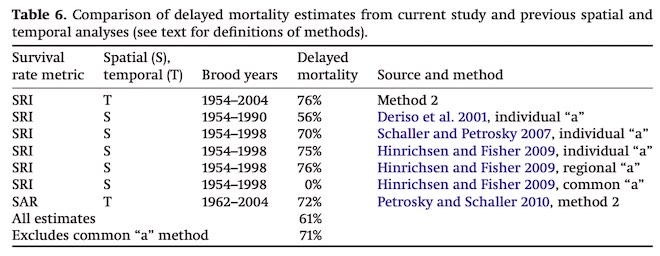forum
library
tutorial
contact

Freshwater Dams are Not the Cause of Dwindling
Chinook Salmon Numbers, According to One Researcher
by James Ferguson
RFD TV, November 30, 2020
|
the film forum library tutorial contact |

|
Freshwater Dams are Not the Cause of Dwindling
by James Ferguson
|
Snake River SARs, calculated from 1964-69, with only Ice Harbor Dam in the lower Snake,
averaged 4.3 percent for wild spring/summer chinook and 7.2 percent for wild steelhead.
 In spite of calls for their removal, dams on the Snake River have little impact on the survival rate of migrating Chinook salmon. That is the finding of one researcher, who has been studying the issue for several years.
In spite of calls for their removal, dams on the Snake River have little impact on the survival rate of migrating Chinook salmon. That is the finding of one researcher, who has been studying the issue for several years.
There are claims that dams contribute to the dwindling number of Chinook salmon. Scientists at British Columbia-based Kintama Research became suspicious of those claims after stumbling upon some key statistics about three and a half years ago.
According to David Welch, the president of the research firm, "Here in British Columbia... the Fraser River is the second largest river on the west coast of North America. There's no dams and this year, unfortunately, we have had historic low returns. They've been grinding down for decades and they're actually down now to the lowest returns on record in over a hundred years."
He says that dams are not the Chinook's problem.
"There's still room for debate, but I think the needle has swung to most folks accepting that the majority of the problems, the survival problems are happening in the ocean," he states.
Welch has never really argued against freshwater travel being the problem for Chinook, until recently.
"You know, it makes sense and all of us that are conservationists, you know hunters and fishermen, are taught that from an early age, but where the challenges come is that the big drivers are happening in the ocean, not so much in freshwater," he explains. "We may be getting some kind of distorted policy decisions because of that lack of appreciation of what's happening in the ocean."
The study found the survival rate is similar for salmon traveling through all west coast rivers, with and without dams, to a common destination, the Pacific Ocean.
Related Pages:
A synthesis of the coast-wide decline in survival of West Coast Chinook Salmon by David Welch, Aswea Porter, Erin Rechisky, Fish and Fisheries, September 17, 2020
learn more on topics covered in the film
see the video
read the script
learn the songs
discussion forum
